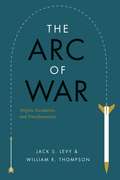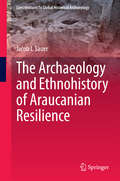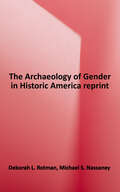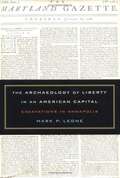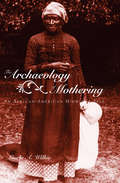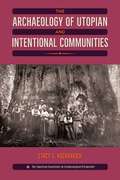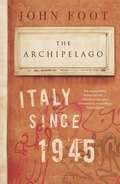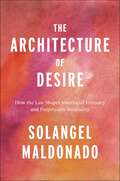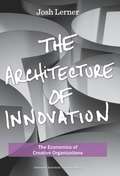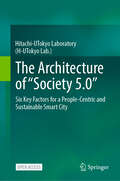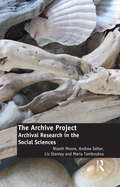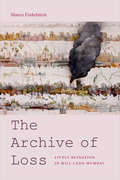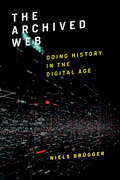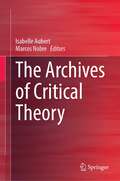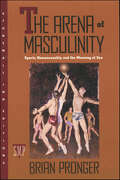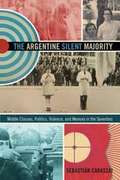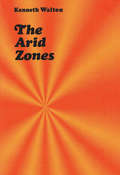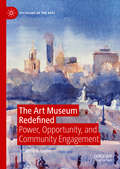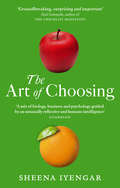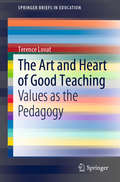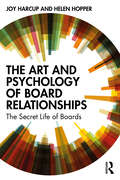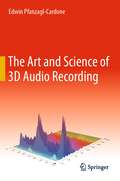- Table View
- List View
The Arc of War: Origins, Escalation, and Transformation
by William R. Thompson Jack S. LevyIn this far-reaching exploration of the evolution of warfare in human history, Jack S. Levy and William R. Thompson provide insight into the perennial questions of why and how humans fight. Beginning with the origins of warfare among foraging groups, The Arc of War draws on a wealth of empirical data to enhance our understanding of how war began and how it has changed over time. The authors point to the complex interaction of political economy, political and military organization, military technology, and the threat environment--all of which create changing incentives for states and other actors. They conclude that those actors that adapt survive, and those that do not are eliminated. In modern times, warfare between major powers has become exceedingly costly and therefore quite rare, while lesser powers are too weak to fight sustained and decisive wars or to prevent internal rebellions. Conceptually innovative and historically sweeping, The Arc of War represents a significant contribution to the existing literature on warfare.
The Archaeology and Ethnohistory of Araucanian Resilience
by Jacob J. SauerThis volume examines the processes and patterns of Araucanian cultural development and resistance to foreign influences and control through the combined study of historical and ethnographic records complemented by archaeological investigation in south-central Chile. This examination is done through the lens of Resilience Theory, which has the potential to offer an interpretive framework for analyzing Araucanian culture through time and space. Resilience Theory describes "the capacity of a system to absorb disturbances and reorganize while undergoing change so as to still retain the same function. " The Araucanians incorporated certain Spanish material culture into their own, rejected others, and strategically restructured aspects of their political, economic, social, and ideological institutions in order to remain independent for over 350 years.
The Archaeology of Gender in Historic America (American Experience in Archaeological Perspective)
by Deborah L. RotmanPatriarchy, colonialism, and the capitalist mode of production have shaped gender through time and across many different cultures. In historic America, gendered social relations were created, codified, and reproduced through the objects used in cultural rituals, the spatial organization of houses, the construction of village landscapes, and the institutions of society, in addition to other social, ideological, economic, and political forces. From domestic spaces to the public realm, Deborah Rotman contextualizes gender and the associated social relationships from the colonial period through the twentieth century. By exploring how individuals and families negotiated and mediated these relationships, she sheds light on how prescriptive gender categories affected those expected to follow them and examines how diverse groups responded to popular gender ideologies. Additionally, she reveals the ways gender and society influence each other, exposing how American normative notions of masculinity and femininity intersect with class, ethnicity, race, sexuality, and identity. Albeit, Rotman contends, they do not intersect in mutually supportive ways, ultimately giving rise to transformative social changes.
The Archaeology of Liberty in an American Capital: Excavations in Annapolis
by Mark P. LeoneAn historical archaeologist examines what nearly 25 years of excavations in Annapolis, Maryland reveal about the methods and means by which this former American capital exerted social control on the powerful and powerless, and with minimal conflict established a wealthy, hierarchical society that symbolized liberty.
The Archaeology of Mothering: An African-American Midwife's Tale
by Laurie A. WilkieUsing archaeological materials recovered from a housesite in Mobile, Alabama, Laurie Wilkie explores how one extended African-American family engaged with competing and conflicting mothering ideologies in the post-Emancipation South.
The Archaeology of Urbanism in Ancient Egypt
by Nadine MoellerIn this book, Nadine Moeller challenges prevailing views on Egypt's non-urban past and argues for Egypt as an early urban society. She traces the emergence of urban features during the Predynastic Period up to the disintegration of the powerful Middle Kingdom state (ca. 3500-1650 BC). This book offers a synthesis of the archaeological data that sheds light on the different facets of urbanism in ancient Egypt. Drawing on evidence from recent excavations as well as a vast body of archaeological data, this book explores the changing settlement patterns by contrasting periods of strong political control against those of decentralization. It also discusses households and the layout of domestic architecture, which are key elements for understanding how society functioned and evolved over time. Moeller reveals what settlement patterns can tell us about the formation of complex society and the role of the state in urban development in ancient Egypt.
The Archaeology of Utopian and Intentional Communities (American Experience in Archaeological Pe)
by Stacy C. KozakavichReconstructing the past of intentional communities from across the United StatesUtopian and intentional communities have dotted the American landscape since the colonial era, yet only in recent decades have archaeologists begun analyzing the material culture left behind by these groups. This volume includes discussions of the Shakers, the Harmony Society, the Moravians, the Oneida community, Brook Farm, and Mormon towns. Also featured is an expanded case study of California's late nineteenth-century Kaweah Colony, offering a new perspective on approaches to the study of utopian societies.Surveys of settlement patterns, the built environment, and even the smallest artifacts such as tobacco pipes and buttons are used to uncover what daily life was like in these communities. Archaeological evidence reveals how these communities upheld their societal ideals. Shakers, for example, constructed homes with separate living quarters for men and women, reflecting the group's commitment to celibacy. On the other hand, some communities diverged from their principles, as evidenced by the presence of a key and coins found at Kaweah, indicating private property and a cash economy despite claims to communal and egalitarian practices.Stacy Kozakavich argues archaeology has much to offer in the reconstruction and interpretation of community pasts for the public. Material evidence provides information about these communities free from the underlying assumptions, positive or negative, that characterize past interpretations. She urges researchers not to dismiss these communal experiments as quaint failures but to question how the lifestyles of the people in these groups are interpreted for visitors today. She reminds us that there is inspiration to be found in the unique ways these intentional communities pursued radical social goals.
The Archipelago: Italy Since 1945
by John FootIn The Archipelago, acclaimed historian John Foot chronicles Italy's tumultuous history from the post-war period to the present. From the silent assimilation of fascists into society after 1945 to the troubling reign of Silvio Berlusconi, and from the artistic peak of neorealist cinema to the celebration of Italy's 150th birthday in 2011, he examines both the corrupt and celebrated sides of the country. <p><p> While often portrayed as a failed state on the margins of Europe, Italy has instead been at the centre of innovation and change – a political laboratory. Through stories of trials, TV programmes, songs and football matches, moments of violence and beauty, epochal social transformation and suffocating continuities, this new history tells the fascinating story of a country always marked by scandal but with the constant ability to re-invent itself. <p> Comprising original research and lively insights, The Archipelago chronicles the crises and modernisations of over seventy years of post-war Italy, from its fields, factories, squares and housing estates to the political intrigue of Rome.
The Architecture of Desire: How the Law Shapes Interracial Intimacy and Perpetuates Inequality (Families, Law, and Society #26)
by Solangel MaldonadoExplores the reach of the law into our most personal and private romantic livesThe Architecture of Desire examines how the law influences our most personal and private choices—who we desire and choose as intimate partners—and explores the psychological, economic, and social effects of these choices. Romantic preferences, as shaped by law, perpetuate segregation and subordination by limiting, on the basis of race, individuals’ prospects for marriage and marriage-like commitments, as well as economic and social mobility.The book begins by tracing the legacy of slavery, anti-miscegenation, segregation, and racially discriminatory immigration laws to show how this legal landscape facilitated the residential, economic, and social distance between racial and ethnic groups, which in turn continue to shape romantic preferences today. Solangel Maldonado argues that the law further influences intimate choices by structuring the spaces within which individuals meet and interact via practices such as redlining, gentrification, and zoning.Maldonado includes studies of online and offline dating preferences to demonstrate that romantic predilections follow a gendered racial hierarchy in which Whites are at the top, African-Americans at the bottom, and—depending on skin tone—Asian-Americans and Latinos in the middle. These preferences may be explicit, implicit, or both, but they are usually the result of stereotypes reflected in social and cultural norms. Furthermore, since marriage confers substantial legal, economic, and social advantages, sexual racism further limits an individual’s opportunity to find a partner and reap these benefits. Finally, the book proposes ways to minimize the law’s influence over who we desire, love, and bring into our families, such as changes to dating platforms as well as to housing, education, and transportation policies.
The Architecture of Innovation
by Joshua LernerFind the right innovation modelInnovation is a much-used buzzword these days, but when it comes to creating and implementing a new idea, many companies miss the mark-plans backfire, consumer preferences shift, or tried-and-true practices fail to work in a new context. So is innovation just a low-odds crapshoot?In The Architecture of Innovation, Harvard Business School professor Josh Lerner-one of the foremost experts on how innovation works-says innovation can be understood and managed. The key to success? Incentives.Fortunately, new research has shed light on the role incentives can play in promoting new ideas, but these findings have been absent from innovation literature-until now. By using the principles of organizational economics, Lerner explains how companies can set the right incentives and time horizons for investments and create a robust innovation infrastructure in the process.Drawing from years of experience studying and advising companies, venture capital firms, and an assortment of governments around the globe, Lerner looks to corporate labs and start-ups, and argues that the best elements of both can be found in hybrid models for innovation. While doing so, he uses a wide range of industry-rich examples to show how these models work and how you can put them into practice in your own organization.Practical and thought-provoking, The Architecture of Innovation is the missing blueprint for any company looking to strengthen its innovation competence.
The Architecture of the Roman Triumph
by Maggie L. PopkinThis book offers the first critical study of the architecture of the Roman triumph, ancient Rome's most important victory ritual. Through case studies ranging from the republican to imperial periods, it demonstrates how powerfully monuments shaped how Romans performed, experienced, and remembered triumphs and, consequently, how Romans conceived of an urban identity for their city. Monuments highlighted Roman conquests of foreign peoples, enabled Romans to envision future triumphs, made triumphs more memorable through emotional arousal of spectators, and even generated distorted memories of triumphs that might never have occurred. This book illustrates the far-reaching impact of the architecture of the triumph on how Romans thought about this ritual and, ultimately, their own place within the Mediterranean world. In doing so, it offers a new model for historicizing the interrelations between monuments, individual and shared memory, and collective identities.
The Architecture of “Society 5.0”: Six Key Factors for a People-Centric and Sustainable Smart City
by Hitachi-UTokyo LaboratoryThis open access book introduces H-UTokyo Lab’s ideas about the architecture for Society 5.0, including the process and organizational infrastructure for building smart cities that embody the Society 5.0 vision. It introduces six factors critical to the success of efforts to build people-centric sustainable smart cities. Each factor represents something needed to enable a local government to build a smart city, address the local issues, and ensure that these efforts contribute toward a people-centric sustainable society. The book is not only focused on initiatives that use digital innovation but extends beyond technological aspects, it also emphasizes the overall architecture—the general structures and organizational designs that encompass digital initiatives among other things. Through this book, readers get a better understanding of the current status of the smart-city agenda and its future path. The book is designed to serve as a handbook for public officials in national and local government, for businesspeople, for academics, for those in the third sector, and for any other actor involved in this undertaking.
The Archive Project: Archival Research in the Social Sciences
by Maria Tamboukou Liz Stanley Niamh Moore Andrea SalterRecent scholarship on archival research has raised questions concerning the character and impact of 'the archive' on how the traces of the past are researched, the use and analysis of different kinds of archived data, methodological approaches to the practicalities involved, and what kind of theory is drawn on and contributed to by such research. The Archive Project: Archival Research in the Social Sciences builds on these questions, exploring key methodological ideas and debates and engaging in detail with a wide range of archival projects and practices, in order to put to use important theoretical ideas that shed light on the methods involved. Offering an overview of the current 'state of the field' and written by four authors with extensive experience in conducting research in and creating archives around the world, it demonstrates the different ways in which archival methodology, practice and theory can be employed. It also shows how the ideas and approaches detailed in the book can be put into practice by other researchers, working on different kinds of archives and collections. The volume engages with crucial questions, including: What is 'an archive' and how does it come into existence? Why do archival research and how is it done? How can sense be made of the scale and scope of collections and archives? What are the best ways to analyse the traces of the past that remain? What are helpful criteria for evaluating the knowledge claims produced by archival research? What is the importance of community archives? How has the digital turn changed the way in which archival research is carried out? What role is played by the questions that researchers bring into an archive? How do we deal with unexpected encounters in the archive? A rigorous and accessible examination of the methods and choices that shape research 'on the ground' and the ways in which theory, practice and methodology inform one another, this book will appeal to scholars across the social sciences and humanities with interests in archival and documentary research.
The Archive of Loss: Lively Ruination in Mill Land Mumbai
by Maura FinkelsteinMumbai's textile industry is commonly but incorrectly understood to be an extinct relic of the past. In The Archive of Loss Maura Finkelstein examines what it means for textile mill workers—who are assumed not to exist—to live and work during a period of deindustrialization. Finkelstein shows how mills are ethnographic archives of the city where documents, artifacts, and stories exist in the buildings and in the bodies of workers. Workers' pain, illnesses, injuries, and exhaustion narrate industrial decline; the ways in which they live in tenements exist outside and resist the values expounded by modernity; and the rumors and untruths they share about textile worker strikes and a mill fire help them make sense of the industry's survival. In outlining this archive's contents, Finkelstein shows how mills, which she conceptualizes as lively ruins, become a lens through which to challenge, reimagine, and alter ways of thinking about the past, present, and future in Mumbai and beyond.
The Archived Web: Doing History in the Digital Age (The\mit Press Ser.)
by Niels Bru¨GgerAn original methodological framework for approaching the archived web, both as a source and as an object of study in its own right.As life continues to move online, the web becomes increasingly important as a source for understanding the past. But historians have yet to formulate a methodology for approaching the archived web as a source of study. How should the history of the present be written? In this book, Niels Brügger offers an original methodological framework for approaching the web of the past, both as a source and as an object of study in its own right. While many studies of the web focus solely on its use and users, Brügger approaches the archived web as a semiotic, textual system in order to offer the first book-length treatment of its scholarly use. While the various forms of the archived web can challenge researchers' interactions with it, they also present a range of possibilities for interpretation. The Archived Web identifies characteristics of the online web that are significant now for scholars, investigates how the online web became the archived web, and explores how the particular digitality of the archived web can affect a historian's research process. Brügger offers suggestions for how to translate traditional historiographic methods for the study of the archived web, focusing on provenance, creating an overview of the archived material, evaluating versions, and citing the material. The Archived Web lays the foundations for doing web history in the digital age, offering important and timely guidance for today's media scholars and tomorrow's historians.
The Archives of Critical Theory
by Marcos Nobre Isabelle AubertOn the occasion of the 100th anniversary of the foundation of the Institute for Social Research in Frankfurt am Main, in 1923, this book aims at shedding light on the archives of some of the key thinkers of Critical Theory of Society, also well known as “Frankfurt School”. To pay homage to this current of thought, this contributed volume aims to make the archives speak for themselves, to show the public the quantity of unpublished material still existing by the authors of the Critical Theory which are now in funds in different parts of the world (in Germany, in Italy, or in the United States), and to show that Critical Theory remains alive 100 years after its inception.The volume starts by presenting the archives of Karl Marx and Friedrich Engels, the thinkers who inspired Critical Theory, and the archives of the Institute for Social Research itself. Then it dedicates separate sections to the archives of Walter Benjamin, Max Horkheimer, Theodor W. Adorno, Friedrich Pollock, Herbert Marcuse, Leo Löwenthal and Jürgen Habermas. The book is composed of chapters written by researchers and editors who worked in the different fonds, as well as chapters written by or interviews with researchers who were or are in charge of some of the archives, or who are especially familiar with the material. The Archives of Critical Theory will be an invaluable tool for researchers in many disciplines working with Critical Theory of Society, such as Sociology, Anthropology, Political Science, Philosophy, History, Education, Law and Cultural Studies, among others. Readers will find information about the content of each archive and the history of its constitution. The various contributions present many ways in which the materials may be explored and explain how such explorations affected or may yet affect the state of the research.
The Arena of Masculinity: Sports, Homosexuality, and the Meaning of Sex
by Brian ProngerSports are perhaps the most visible expression of the ideals of masculinity in our society, and figure as a training ground on which young boys are taught what it means to be a man. Given the involvement of sports with masculinity, the homosexual athlete becomes a paradox, and the recent explosive growth of gay sporting leagues, a puzzle.Pronger explores the paradoxical position of the gay athlete in a straight sporting world, examines the homoerotic undercurrent subliminally present in the masculine struggle of sports, and explicates the growth of gay sports in the framework of the developing gay culture.
The Argentine Silent Majority: Middle Classes, Politics, Violence, and Memory in the Seventies
by Sebastián CarassaiIn The Argentine Silent Majority, Sebastián Carassai focuses on middle-class culture and politics in Argentina from the end of the 1960s. By considering the memories and ideologies of middle-class Argentines who did not get involved in political struggles, he expands thinking about the era to the larger society that activists and direct victims of state terror were part of and claimed to represent. Carassai conducted interviews with 200 people, mostly middle-class non-activists, but also journalists, politicians, scholars, and artists who were politically active during the 1970s. To account for local differences, he interviewed people from three sites: Buenos Aires; Tucumán, a provincial capital rocked by political turbulence; and Correa, a small town which did not experience great upheaval. He showed the middle-class non-activists a documentary featuring images and audio of popular culture and events from the 1970s. In the end Carassai concludes that, during the years of la violencia, members of the middle-class silent majority at times found themselves in agreement with radical sectors as they too opposed military authoritarianism but they never embraced a revolutionary program such as that put forward by the guerrilla groups or the most militant sectors of the labor movement.
The Arid Zones
by Hilton KramerThe hot and temperate deserts and their marginal steppe lands comprise one-third of the land surface of the world and are an increasingly critical area for the economic wellbeing of world populations. The remarkable mechanisms of floral, faunal, and human adaptation to the distinct and difficult environment of these arid zones, as well as the potential of modern technology for facilitating adaptation, are described and explained by Walton in the light of our most recent knowledge of the phenomena and processes involved.Beginning with a clarification of the definitions of arid and semi-arid regions and with the delineation of techniques for measuring the degree of aridity in these areas, the author shows that there is wide variation among the arid zones in landscape and climate and that there are numerous local and microclimates within any single arid region. The life cycles of the plants and animals of the arid zones are described and the water resources, including problems of salinity, mineral contamination, and the construction of reservoirs, are examined. Extensive treatment is given to potential agricultural adaptations and to pastoralism as the most widespread response to dry land. A final chapter summarizes attempts at adaptation to prevailing drought and discusses the kinds of future development that the author deems most likely in arid zones.Throughout the book emphasis is placed on specific, detailed analysis, with adequate tables and formulas for in-depth understanding of particular aspects of aridity. Examples from both Old and New Worlds are used to demonstrate the spheres in which progress is being made and to show the mistakes in past and present land use in arid areas. An essential supplement for courses in physical geography, the book will be useful in many area studies and in studies of economic development.
The Art Museum Redefined: Power, Opportunity, and Community Engagement (Sociology of the Arts)
by Johanna K. TaylorThis book presents a critical analysis of the power and opportunity created in the implementation of community engaged practices within art museums, by looking at the networks connecting art museums to community organizations, artists and residents. The Art Museum Redefined places the interaction of art museums and urban neighbourhoods as the central focus of the study, to investigate how museums and artists collaborate with residents and local community groups. Rather than defining the community solely from the perspective of a museum looking out at its audience, the research examines the larger networks of art organizing and creative activism connected to the museum that are active across the neighbourhood. Taylor's research encompasses the grassroots efforts of local groups and their collaboration with museums and other art institutions that are extending their reach outside their physical walls and into the community. This focus on social engagement speaks to recent emphasis in cultural policy on cultural equity and inclusion, creative place-making and community engagement at neighbourhood and city-levels, and will be of interest to students, scholars and policy-makers alike.
The Art Of Choosing: The Decisions We Make Everyday of our Lives, What They Say About Us and How We Can Improve Them
by Sheena IyengarEvery day we make choices. Coke or Pepsi? Save or spend? Stay or go?Whether mundane or life-altering, these choices define us and shape our lives. Sheena Iyengar asks the difficult questions about how and why we choose: Is the desire for choice innate or bound by culture? Why do we sometimes choose against our best interests? How much control do we really have over what we choose? Her award-winning research reveals that the answers are surprising and profound. In our world of shifting political and cultural forces, technological revolution, and interconnected commerce, our decisions have far-reaching consequences. Use this book as your companion and guide for the many challenges ahead.'No one asks better questions, or comes up with more intriguing answers' Malcolm Gladwell, author of THE TIPPING POINT
The Art and Heart of Good Teaching: Values as the Pedagogy (SpringerBriefs in Education)
by Terence LovatThis book summarizes and updates findings from the Australian Values Education Program with a focus on the latest international research in the field, both theoretical and practice-based. Further, it provides a theoretical and practical basis for understanding the disenchantment with low-level accountability approaches to learning (e.g. NAPLAN in Australia). In turn, the book demonstrates the effectiveness of Values Education as a holistic pedagogy with the potential to enhance students’ learning effects in terms of their personal, social, emotional and academic development. It offers well-tested alternative pedagogical approaches, based on research insights largely originating from actual classroom-based practice.
The Art and Psychology of Board Relationships: The Secret Life of Boards
by Joy Harcup Helen HopperThe relationships within boards can make or break an organisation, but well-functioning relationships take skill and effort to maintain. This book looks at the psychology behind individual and group behaviour and offers tactics and power tools to help make a success of your board career. The book shares advice and practical tips from 40 experienced board members from the worlds of corporates, the public sector and charities on how to spot and manage complex dynamics. And each chapter ends with techniques for unlocking tricky board relationships that you can put into practice immediately. The authors examine case studies and explore topics such as psychodynamics, cognitive behavioural psychology and neuroscience for insights into how boards react under pressure. They then demonstrate how to practise the ART of managing board relationships by increasing Awareness, Relating constructively to others, and choosing Tactics to ease tensions and foster collaboration. The Art and Psychology of Board Relationships: The Secret Life of Boards reveals why board relationships lie at the heart of organisational success – and how you can use them to gain competitive edge. It is essential reading for current and aspiring board members, coaches, facilitators and anyone with an interest in boardroom dynamics.
The Art and Science of 3D Audio Recording
by Edwin Pfanzagl-CardoneThis professional book offers a unique, comprehensive and timely guide on 3D audio recording. Intended for sound engineers and professionals, and summarizing more than twenty-year research on this topic, it includes extensive information and details on various microphone techniques and loudspeaker layouts, such as Auro-3D®, Dolby® AtmosTM, DTS:X®, MMAD, SONY 360 Reality Audio and Ambisonics. It presents a rich set of results obtained from both objective measurements and subjective listening tests, and a number of case studies for 3D recording, ranging from solo-instrument techniques to full symphony orchestra, and microphone systems for virtual reality applications. Further, it includes a chapter on spatial hearing discussing issues of 3D audio sound reproduction. All in all, this book offers extensive, practical information for sound engineers and professionals.
